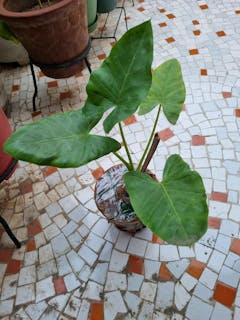Cobra Lily
Family
Araceae
Origin
India, Nepal
Description
Arisaema Concinnum is a perennial herb with reddish stem stems 20-25 cm in height. The plant has a single digitately compound leaf. Leaf is wonderfully symmetrical, whorled like a Chinese Umbrella of leaflets. Foliage green marked at the edges with red and ribbed beneath.
Arisaema Costatum features bold red and green hooded flowers accompanied by rich foliage. It blooms from April to June in plains and May to July in hilly areas. For a distinctive summer display, plant the bulbs between February and April or March and May.
Environment
Cool, dappled shade under a spreading canopy of trees is ideal for growing arisaema. However, the north or east side of a building, that protects them from all day sun and heat will work as well. While arisamea can and do thrive in an astonishing array of countries and elevations, it is critical to get the specific conditions right for them to flourish in your garden. The soil must be moist but not wet, with excellent drainage to ensure the tubers and roots do not rot.
Arisaema are highly prone to rot in poorly drained conditions. The soil should also be porous – with plenty of air spaces. Work the soil well to break up any compacted areas, and incorporate leaf mold, compost and perlite to improve both the nutrition and structure of the soil. Raised beds or small hillocks will also help you to achieve the level of drainage so important for happy cobra lilies. & excellent drainage. It should be planted with plenty of sharp sand and coarse bark immediately surrounding the tubers & will thrive in an organically-rich surrounding substrate with plenty of leaf mould and humus.
Plant arisaema tubers 4-6 inches deep, to give them a good opportunity to develop a healthy network of roots, and to protect from cold in the lower zones of their hardiness range. Arisaema should be kept lightly moist, but not wet. Excellent drainage is critical to ensuring your tubers do not rot. Once potted they should be watered sparingly when their new roots are shoot emerging, thus minimizing the chances of the tuber rot. Water in the evenings with a sprinkler or watering can when the soil is dry
When the root system has developed and leaves begin to unfold from the leaf-sheates, they can be watered regularly and fertilized with slow release fertilizers.
Once the flowering is complete and the leaves turn yellow, watering should be discontinued and tubers given rest during their dormancy period.
Landscape Use
Arisaema makes a bold statement in the garden & can be used in indoor gardens and balconies. It is also used as back border or focal plant due to its height, beautiful trumpet-shaped flowers and leaf texture.





















